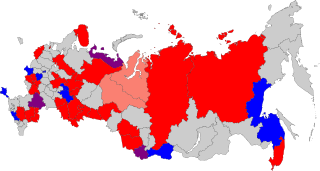
Karachay-Cherkessia, officially the Karachay-Cherkess Republic, is a republic of Russia located in the North Caucasus. It is administratively part of the North Caucasian Federal District. As of the 2021 census, Karachay-Cherkessia has a population of 469,865. Cherkessk is the largest city and the capital of the republic.

Khanty-Mansi Autonomous Okrug — Yugra, also known as Khantia-Mansia, is a federal subject of Russia. It has a population of 1,532,243 as of the 2010 Census. Its administrative center is located at Khanty-Mansiysk.

The Yamalo-Nenets Autonomous Okrug or Yamalia is a federal subject of Russia and an autonomous okrug of Tyumen Oblast. Its administrative center is the town of Salekhard, and its largest city is Novy Urengoy. The 2021 Russian Census recorded its population as 510,490.

An Autonomous Soviet Socialist Republic was a type of administrative unit in the Soviet Union (USSR), created for certain ethnic groups to be the titular nations of. The ASSRs had a status lower than the constituent union republics of the USSR, but higher than the autonomous oblasts and the autonomous okrugs.

Autonomous okrugs are a type of federal subject of the Russian Federation and simultaneously an administrative division type of some federal subjects. As of 2024, Russia has four autonomous okrugs of its 83 federal subjects. The Chukotka Autonomous Okrug is the only okrug which is not subordinate to an oblast. The Nenets Autonomous Okrug is a part of Arkhangelsk Oblast, the Khanty-Mansi Autonomous Okrug and the Yamalo-Nenets Autonomous Okrug are parts of Tyumen Oblast.

Russia is divided into twelve economic regions — groups of federal subjects sharing the following characteristics:

The federal subjects of Russia, also referred to as the subjects of the Russian Federation or simply as the subjects of the federation, are the constituent entities of Russia, its top-level political divisions. According to the Constitution of Russia, the federation consists of republics, krais, oblasts, cities of federal importance, an autonomous oblast, and autonomous okrugs, all of which are equal subjects of the federation.

.ru is the Latin alphabet Internet country code top-level domain (ccTLD) for Russia introduced on 7 April 1994. The Russian alphabet internationalized country code is .рф.

Of all the languages of Russia, Russian, the most widely spoken language, is the only official language at the national level. There are 25 other official languages, which are used in different regions of Russia. These languages include; Ossetic, Ukrainian, Buryat, Kalmyk, Chechen, Ingush, Abaza, Adyghe, Cherkess, Kabardian, Altai, Bashkir, Chuvash, Crimean Tatar, Karachay-Balkar, Khakas, Nogai, Tatar, Tuvan, Yakut, Erzya, Komi, Hill Mari, Meadow Mari, Moksha, and Udmurt. There are over 100 minority languages spoken in Russia today.

This gallery of flags of federal subjects of Russia shows the flags of the 89 federal subjects of Russia including 2 regions that, while being de facto under complete Russian control, are not internationally recognized as part of Russia, and 4 regions that, while not being fully controlled by Russia or recognised internationally, are claimed by it as its federal subjects.

Beryozovsky District is an administrative and municipal district (raion), one of the nine in Khanty-Mansi Autonomous Okrug of Tyumen Oblast, Russia. It is located in the northwest of the autonomous okrug on the left bank of meridional part of the Ob River within the limits of North Sosva altitudes and the east slope of the North and Pre-Polar Ural and borders with the Komi Republic in the west and with Shuryshkarsky District of Yamalo-Nenets Autonomous Okrug in the north. The area of the district is 90,000 square kilometers (35,000 sq mi). Its administrative center is the urban locality of Beryozovo. Population: 25,744 ; 27,170 (2002 Census); 28,256 (1989 Soviet census). The population of Beryozovo accounts for 28.3% of the district's total population.

Russia, the largest country in the world, has international land borders with fourteen sovereign states as well as 2 narrow maritime boundaries with the United States and Japan. There are also two breakaway states bordering Russia, namely Abkhazia and South Ossetia. The country has an internationally recognized land border running 22,407 kilometres (13,923 mi) in total, and has the second-longest land border of any country in the world, after China. The borders of the Russian Federation were mostly drawn since 1956, and have remained the same after the dissolution of the Soviet Union. In 2014, Russia annexed Ukraine's Crimean peninsula in a move that remains internationally unrecognized.
Balkar and Karachay nationalism is the national sentiment among the Balkars and Karachai. It generally manifests itself in:

Election Day in Russia was held on September 14, 2014.

Election Day in Russia was 18 September 2016. Among them were the legislative election for the 7th State Duma, nine gubernatorial elections, 39 regional parliamentary elections, and many elections on the municipal and local level.

The 2019 Russian regional elections took place on 8 September 2019 for the election of governors in 19 subjects, among which 16 by direct votes and 3 by indirect votes, and of legislatives bodies in 13 subjects.

Legislative constituencies are used in Russia to elect half of the seats (225) in the State Duma. Each Federal Subject gets a certain amount of constituencies, proportional to their population, with every Federal Subject getting at least one. Every constituency is a single-mandate one, meaning each constituency sends one representative to the State Duma.

Numerous proposed federal subjects have been put forward since the dissolution of the Soviet Union that would partition existing federal subjects of the Russian Federation. Many new federal subjects were declared in the 1990s, most of them were not recognized, while others, like Adygea and Altai Republics, which were previously autonomous oblasts, were recognized.















